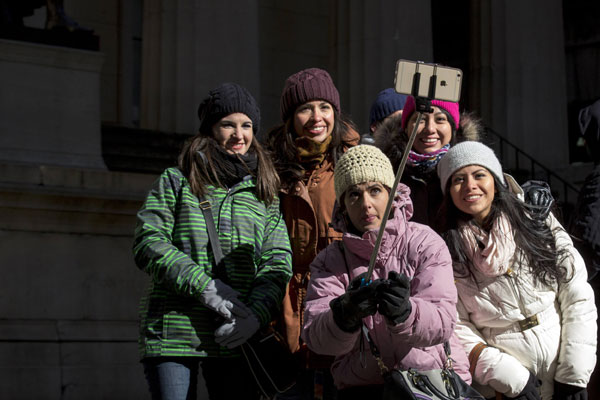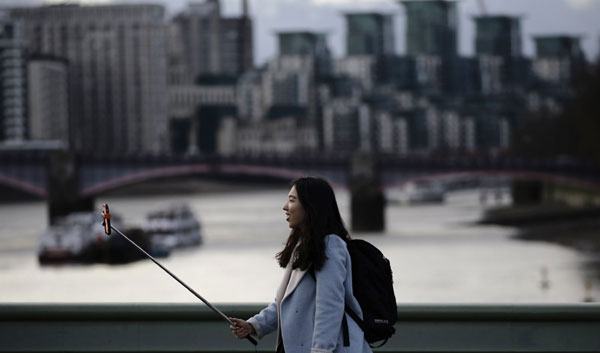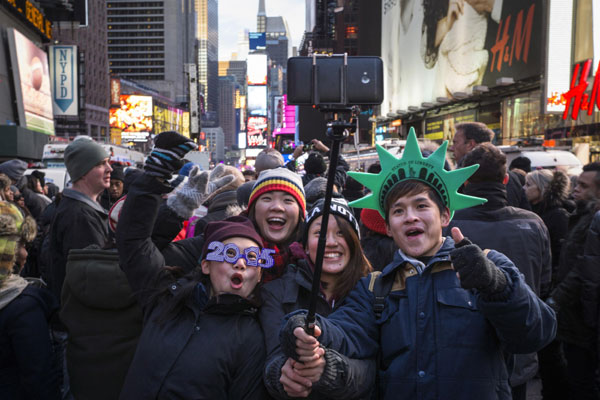As popular as they are globally, selfie sticks are being asked to stay away from more places. Now the Palace Museumhas become skeptical about the selfie-enhancing device, too.
Museums take the lead
Out of safety concern, a number of museums took the lead earlier this year to ban selfie sticks in order to protect their artworks and visitors. Several major museums in other countries have said 'no' to the device, including the Rome's Colosseum, the Smithsonian museums in Washington and the National Portrait Gallery in the UK. More Chinese museums are joining the international trend as well, for example, the Nanjing Museum, which took the step last week.
Although the Palace Museum has not issued an official ban, the museum's administration has recently warned visitors to be more careful with the gadget. If the device is used in crowded place or narrow area, the staff is likely to walk up and stop it. Selfie sticks are also advised to stay outside the exhibition area in the museum, as the stretchable device can be disturbing to other visitors and dangerous to the museum objects.
Outside the museums, many international soccer teams have also banned the selfie stick from their stadiums out of shared concern. They are worried that agitated fans might use the device as a weapon.
It is still a question whether sefie sticks will be challenged in more casual occasions like amusement parks, but the Tokyo Disneyland officially bans the use of selfie stick inside the theme park area.
The voices
The Louvre museum in Paris has not yet banned selfie sticks, but an action is expected to be announced in a few weeks. An executive of the museum told a foreign media his concern: More visitors are waving the devices high in the air, and some of them are only few centimeters away from the famed original Mona Lisa.
"Museum photos are good for spreading the cultural messages, but we should pay attention to our ways," said Cao Wei, a celebrated Sina Weibo blogger. "I support the museums' actions on the selfie stick ban."

Tourists use a selfie stick for a photograph in New York's financial district Feb 13, 2015. [Photo/Agencies]
"Different from other tourist attractions, museums carry a function to educate and present different culture,? said a cultural expert surnamed Gao. "Using a selfie stick not only breaks the quiet environment but also disturbs other visitors."
"If the phone drops off the stick in crowded place, it can pose danger to other people and cause loss to museum objects," said a young woman surnamed Xu in a report. "The aim to take a better photo is understandable, but it?s better not to use it."
Different from other museum, a computer museum in the UK somehow maintains a generous attitude to selfie sticks. "We welcome people to take photos here with selfie sticks. If they break an old computer, we can replace it with another one," said a museum personal. "But we support other museums' actions. If a selfie stick breaks an ancient vase, it is completely a different story."
Safety concerns
Extendable to as long as 1.5 meters, any photo dropped from that device can be dangerous. We have also witnessed people using selfie sticks slamming into other people faces.
"Once, I was walking and a selfie stick suddenly popped out in front me," said a Guangzhoucitizen surnamed Li. "It almost hit me before I ducked away in time!"
Priced between several dollars to over a hundred on Taobao, the selfie sticks can vary a lot in the quality. The safety standards of selfie sticks are yet to be defined in China, and it is unknown whether the electromagnetic wave created by the device can cause harm to human body.
In South Korea, selfie sticks face a tougher attitude. Selling a selfie stick could mean a fine of up to $27,000 and a prison term of three years, if the gadget is unregistered.

A woman takes a photo using a selfie stick whilst standing on Westminster Bridge in London Jan 10, 2015. [Photo/Agencies]

People use a selfie stick to photograph themselves during New Year's Eve celebrations in Times Square, New York, Dec 31, 2014. [Photo/Agencies]